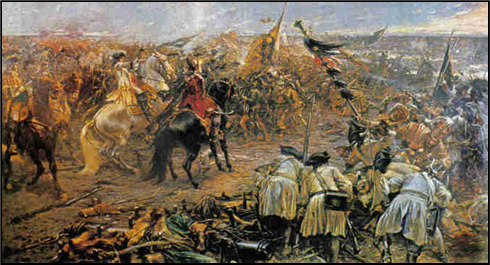


xxxxxAs we have seen, the defeat of the Ottoman Turks at the Battle of Kahlenberg in 1683 (C2), which prevented them taking Vienna, led to a counter offensive. The Austrians drove the Turks out of most of Hungary, and then gained a resounding victory at the Second Battle of Mohacs in 1687. But the most significant blow to Turkish ambitions in Europe came ten years later in 1697 when the Austrians, led by Prince Eugene of Savoy, met and virtually annihilated the Turkish army at the Battle of Zenta. This paved the way for the Treaty of Karlowitz in 1699, a settlement which made Austria the dominant power in east-
THE BATTLE OF ZENTA 1697 (W3)
Acknowledgements
Zenta: by the Serbian painter Franz Eisenhut (1857-
xxxxxAs we have seen, the failure of the Ottoman Turks to take the city of Vienna in 1683 (C2) following their defeat at the Battle of Kahlenberg, opened the way for a counter offensive. The Holy League was formed between Austria, Poland and Venice (and supported by Russia) with the aim of recapturing areas of eastern and central Europe. Over the next four years, Charles of Lorraine, the  Austrian field marshal who had taken a major role in the defence of Vienna, drove the Turks out of most of Hungary, and in August 1687 sealed his success with a resounding victory at the Second Battle of Mohacs.
Austrian field marshal who had taken a major role in the defence of Vienna, drove the Turks out of most of Hungary, and in August 1687 sealed his success with a resounding victory at the Second Battle of Mohacs.
xxxxxBut the final blow to Turkish hopes of becoming a major power in central Europe came ten years later in September 1697, when they were finally expelled from all but a small part of Hungary. The Austrians, led by Prince Eugene of Savoy, caught up with the Ottoman Turks just outside Zenta -
Including:
The Treaty
of Karlowitz

xxxxxThe Treaty of Karlowitz in 1699 greatly reduced Turkish influence in east-
 xxxxxThe Battle of Zenta paved the way for the Treaty of Karlowitz two years later. This wide ranging settlement greatly diminished Turkish influence in east-
xxxxxThe Battle of Zenta paved the way for the Treaty of Karlowitz two years later. This wide ranging settlement greatly diminished Turkish influence in east-
xxxxxAs we shall see (G1 1718), the Ottoman Empire again went on the offensive in 1715, but during the remainder of the 18th century a series of wars against Russia and Austria accelerated the empire's decline and led to the loss of more territory. There remained a serious lack of leadership, and this hampered any meaningful reform.
W3-


